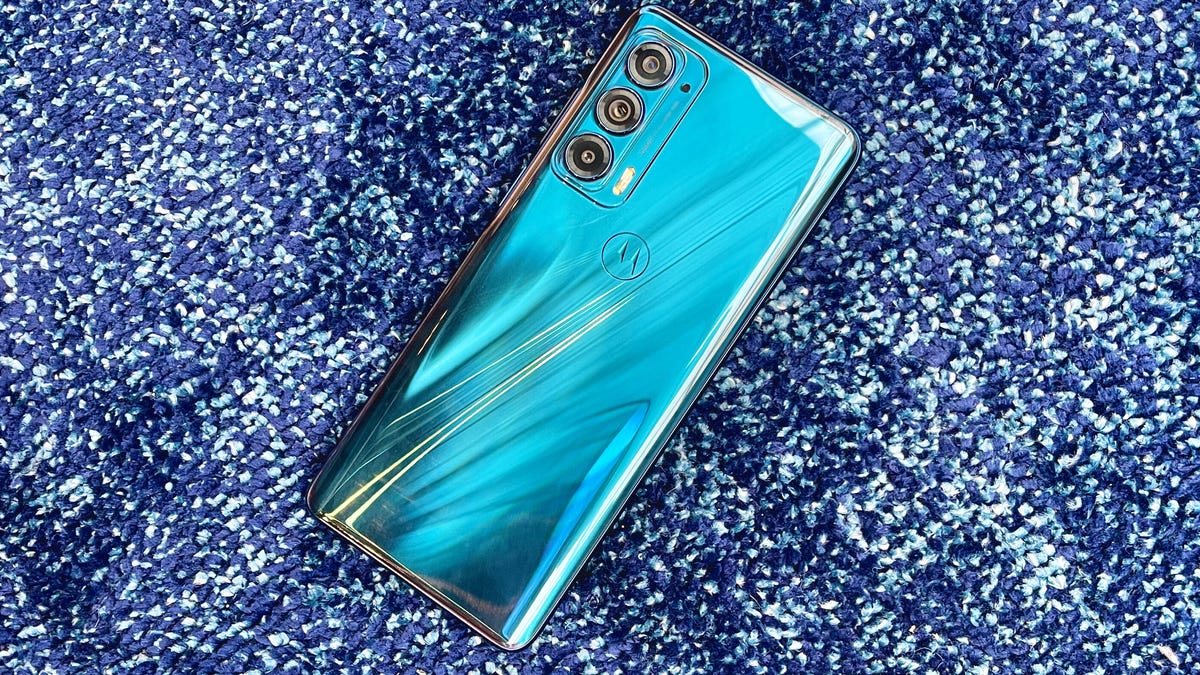New Motorola Edge loses the curved display, adds a 144Hz refresh rate
The curved screen isn't part of the $700 Edge anymore, but buttery-smooth animations should make up for that.

The Motorola Edge will cost $700 in the US.
Motorola is revealing the new Motorola Edge for 2021 Thursday, updating its higher-end phone as part of an in-person event at Yankee Stadium in New York. The Edge (not to be confused with the U2 guy, of course) will cost $700 in the US, a price that roughly converts to £515 or AU$975. For that sum, Motorola is including impressive upgrades to the phone's display and camera, while simplifying its line to just the Edge, as opposed to last year's Edge and Edge Plus.
To tempt you even more, Motorola is running a deal where you can get an Edge for $500. That's $200 off. The Motorola Edge will commence presale starting Aug. 23 and will launch on Sept. 2.
The Motorola Edge's most obvious 2021 update will be its 144Hz high refresh rate display alongside a 108-megapixel main camera, which will be paired up with several of Motorola's software upgrades for wirelessly connecting your phone to a TV for gaming, video calls and more.
Unlike the previous Edge phones, named for the curved display, this year's Edge has a decidedly flat screen. The Edge name is instead referring to "cutting edge" technology included in the phones. Removing the curved sides was a reaction to how people are making use of their phones now, Motorola noted, as opposed to a year and a half ago.
The Motorola Edge has a 144Hz high-refresh rate display
The 6.8-inch display supports a 144Hz refresh rate, which is faster than the 120Hz rate on phones from OnePlus and Samsung and closer to the range of gaming phones like the the Asus ROG Phone 5. I won't even discuss the iPhone and its 60Hz refresh rate.
A high-refresh-rate screen isn't just about gaming. Mundane things like Android animations and scrolling through feeds look so much better, too. Keep in mind, the difference between 144Hz and 120Hz isn't huge. The idea is to stay in front of upgrades, especially if you plan on keeping the Edge for two, three or more years.
Better photos with Low-Light AI selfies
Camera-wise, there is a 108-megapixel main camera that uses pixel-binning to combine nine pixels into what Motorola calls an "Ultra Pixel." You can toggle between the default 12-megapixel capture setting and a high-resolution mode if you're so inclined.
There is also an ultrawide-angle camera which doubles as a macro camera for getting those up-close-and-personal shots of food or tiny details. Rounding out the rear camera is a 2-megapixel depth camera that works with the main camera to take portrait mode photos.
On the front is a 32-megapixel selfie camera which might be the highest resolution front-facing camera ever on a Motorola phone. One of the coolest features is a new automatic setting called Low-Light AI selfie. When you're shooting in low light, the Edge uses artificial intelligence to identify and improve areas in the photo to make things brighter, reduce image noise and enhance color. And what's great is you don't have to turn it on. It's automatically triggered when the lighting you're in is below a certain lux level.
Also, Low-Light AI selfie mode is different from night vision mode, which uses image stacking instead of AI. This new feature works in real time, meaning you can see it in your camera's viewfinder live preview.
Ready For the Motorola Edge
Motorola is also continuing to develop its Ready For software, which is its latest way to extend your phone's features onto other screens like your TV and your computer. Earlier this year, the software allowed its phones to function as a webcam for your computer, and at today's event Motorola highlighted Ready For as being useful for connecting your phone to a TV for gaming, video chats, desktop productivity and other features. For gaming in particular, the software will support using a Bluetooth controller
For video calls, you can use the higher-quality cameras on the Edge and still use the big screen of a TV or computer monitor to see the call. All of your mobile apps can show up in resizable, floating windows for a really nice, desktop-type experience.
There is already a Ready For spinoff called Ready For PC which lets you access your phone apps and your PC files and apps on the same screen. The effort is nothing new for Motorola, which has been making laptop docks for its phones as far back as 2011, for its Atrix phones of that era.
Other specs for the Motorola Edge in 2021 include its Qualcomm Snapdragon 778G system on a chip and either 6GB or 8GB of RAM. The Edge has a big ol' 5,000-mAh battery, supports 30-watt fast-charging and sub-6 5G along with 5G mmWave networks. But with all of these specs flying in the air for the Edge, wireless charging did not make it onto the phone.

